
The Filmation “Tarzan”
Suspended Animation #321
“The jungle: Here I was born; and here my parents died when I was but an infant. I would have soon perished, too, had I not been found by a kindly she-ape named Kala, who adopted me as her own and taught me the ways of the wild.
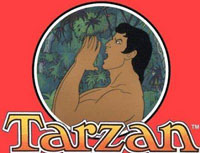 “I learned quickly, and grew stronger each day, and now I share the friendship and trust of all jungle animals. The jungle is filled with beauty, and danger; and lost cities filled with good and evil.
“I learned quickly, and grew stronger each day, and now I share the friendship and trust of all jungle animals. The jungle is filled with beauty, and danger; and lost cities filled with good and evil.
“This is my domain, and I protect those who come here; for I am Tarzan, Lord of the Jungle!”
That was the opening voice-over done by actor Robert Ridgely (who also provided the voice for Flash Gordon and Thundarr) for the Filmation Tarzan Lord of the Jungle series produced for thirty-six episodes by Filmation from 1976 through 1980 (although it continued in rerun episodes through 1982) that ran on CBS Saturday morning. That opening montage was storyboarded by Bob Kline.

Johnny Weismuller’s Tarzan in Tex Avery’s “Hollywood Steps Out” (1941)
Burroughs himself contacted MGM about buying the proposed animated series. MGM was anxious to keep Burroughs happy since they were enjoying success with their live action Johnny Weissmuller film version of Tarzan and they were generally dissatisfied with their animated short subjects at the time.
However, MGM felt that Clampett’s realistic space fantasy approach would be difficult to sell because it was too strange.
Burroughs suggested a cartoon series featuring Tarzan who was already a well-known and well-loved character by the public. He would operate his own cartoon studio called Tarzantoons Inc. (initially to be located in Beverly Hills because of its nearness to Hollywood) and with Burroughs’ son John Coleman Burroughs in charge of the studio.

Clampett’s proposed Tarzan
The characters of Tarzan, Jane, and Muviro, Tarzan’s African native friend, were to be handled in a straight illustrative style. The animals were all going to be drawn as exaggerated cartoony characters.
As ERB started to look at the costs for setting up the studio, he began to have second thoughts as well as seeing the lack of enthusiasm by Clampett in this project with Clampett returning to Warners. ERB didn’t cancel the cartoons but decided to postpone making them for the time.
He had personally written two Tarzan scripts for the cartoons: “Nkima, Mighty Hunter, Mighty Fighter” and “Tarzan and Tantor.” The first script dealt with the humorous misadventures of Tarzan’s monkey friend, while the second was an adaptation of one of the stories, “The Capture of Tarzan,” from the book, Jungle Tales of Tarzan.
Clampett said, “I was very inspired by the Mars project. As much as I like Tarzan, to do the alternate series was simply not the same. Somehow, I just lost my enthusiasm for the new project.”
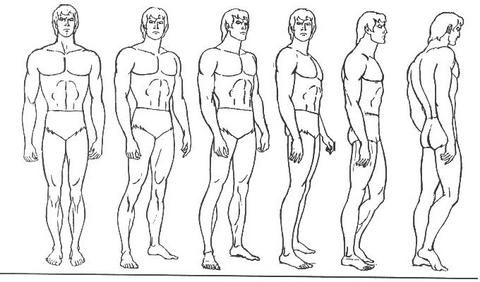
A model sheet for the Filmation “Tarzan”
Tarzana is a suburban neighborhood in the San Fernando Valley area of Los Angeles that was the site of the ranch owned by author Edgar Rice Burroughs and named after his fictional creation Tarzan.
Filmation producer Lou Scheimer lived there and while thinking about potential projects for his animation studio it was natural to think of translating The Lord of the Jungle to animation. He met with Burroughs’ family that ran ERB Inc. to try to convince them to let him use the character.
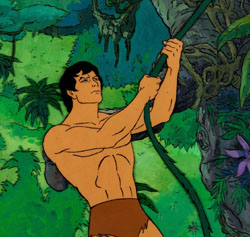 Scheimer’s plan was to do an animated feature film that would introduce the character, his origin and more in order to set up a television series as Scheimer would later do with his version of Flash Gordon. Writer David Gerrold wrote a script but made changes to the original story that Burroughs’ grandson Danton hated resulting in Gerrold leaving Filmation and the project almost cancelled.
Scheimer’s plan was to do an animated feature film that would introduce the character, his origin and more in order to set up a television series as Scheimer would later do with his version of Flash Gordon. Writer David Gerrold wrote a script but made changes to the original story that Burroughs’ grandson Danton hated resulting in Gerrold leaving Filmation and the project almost cancelled.
Eventually, the situation was worked out and Scheimer and Danton became friends. Danton even did the famous Tarzan yell for the series.
“The most important part was to do a show with a hero who was really sort of normal adult,” said Scheimer to author Andy Mangels. “He couldn’t fly; he couldn’t do all the superhero stuff but he had that capacity to work with animals. There was no place in the world where you could go where you couldn’t sell Tarzan. It eventually sold like hotcakes all over the world. It was very, very successful.
“There were twenty-four novels and we developed our stories from some of them and created others that were more appropriate for our more enlightened time or more fun for children. We tried to keep it so that there was some talk about preservation, how to treat animals and treating the other human denizens of the jungle with sensitivity. And we made the decision to have him speak. He was fully articulate and intelligent.”
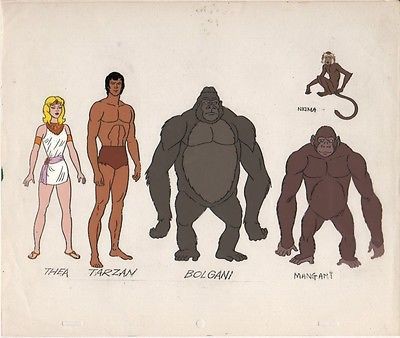
The show was considered the most faithful adaptation of the Tarzan books ever put to film with much of the writing by Len Janson and Chuck Menville either as a team or separately. Having lost civilizations skirted the issues of jungle natives.
The Mangani language from the books was also liberally used. Tarzan spoke of Tantor the Elephant, Numa the Lion, Usha the wind, and admonished jungle animals to “unk!” (leave) when dismissing them. No Cheeta the Chimp from the movies. Tarzan had his spider monkey companion N’kima (voiced by Scheimer) and even Jad-bal-ja the Golden Lion made his appearance.
Jane did not appear until an episode specifically requested by the Burroughs’ estate so hey could re-secure the rights to the character who hadn’t been used since 1959.
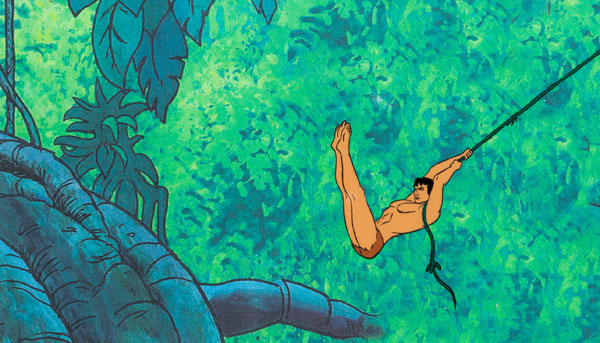
To achieve a realistic human figure that resembled the classic work of artist Burne Hogarth on the Sunday Tarzan newspaper strip, Tarzan was rotoscoped.
“Our rotoscope model was a bartender from the bar down the street from Filmation called The Dug Out where some of our animators would disappear for a couple of hours,” said Scheimer. “Tarzan was always jumping through trees; grabbing vines, and running and swimming. He moved all the time doing things.”
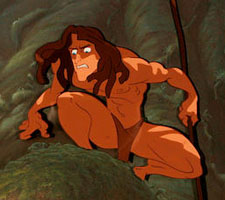
Disney’s Tarzan
After Filmation Studios was sold to L’Oreal, Scheimer started his own company and re-purchased the Tarzan rights for a new series to be called The Fantastic World of Tarzan that would focus on environmental, science-fiction and prehistoric elements like using Pellucidar.
Jane would be a redheaded photojournalist. A ten year old native boy named Quai would be mentored by Tarzan One storyline had La, the alien Queen of Xenopia, stranded in her spaceship The Opar along with her insectoid warriors.
Scheimer felt that the series didn’t sell because the networks were still angry at him about how Filmation had opened the door to syndicated animation.
Tarzan would not appear in animation again until 1999 with Walt Disney’s Tarzan and later as an animated television show in September 2001 with Disney’s Legend of Tarzan.


 Jim Korkis is an internationally respected animation historian who in recent years has devoted his attention to the many worlds of Disney. He was a columnist for a variety of animation magazines. With his former writing partner, John Cawley, he authored several animation related books including The Encyclopedia of Cartoon Superstars, How to Create Animation, Cartoon Confidential and Get Animated’s Animation Art Buyer’s Guide. He taught animation classes at the Disney Institute in Florida as well as instructing classes on acting and animation history for Disney Feature Animation: Florida.
Jim Korkis is an internationally respected animation historian who in recent years has devoted his attention to the many worlds of Disney. He was a columnist for a variety of animation magazines. With his former writing partner, John Cawley, he authored several animation related books including The Encyclopedia of Cartoon Superstars, How to Create Animation, Cartoon Confidential and Get Animated’s Animation Art Buyer’s Guide. He taught animation classes at the Disney Institute in Florida as well as instructing classes on acting and animation history for Disney Feature Animation: Florida.




















































A well-crafted animated series with excellent production values and strong voice acting. This is probably the truest version of Tarzan to be put on film. There seems to be some influence of the Dell comics drawn by Jesse Marsh. Though the animation is somewhat limited, it’s fairly realistic. And each storyline has substance sufficient to sustain a half-hour episode. This is a highly enjoyable series, and very watchable.
David Gerrold would have been brought to the Tarzan project on the strength of his having written a couple of episodes of Filmation’s Star Trek: the Animated Series. (He had previously written “The Trouble with Tribbles”, and co-written “The Cloud Minders”, for the Original Series when he was in his early twenties.) After being dismissed from Tarzan, he went on to help develop Sid and Marty Krofft’s “Land of the Lost”. I recall an interview in which he said that getting fired by Filmation was a blessing in disguise, but other than that he declined to talk about the experience. I’d like to know what exactly he did with the story and why the Burroughs estate objected to it.
Probably a motivating factor behind Filmation’s Tarzan series was the 1975 French animated feature “Tarzoon: Shame of the Jungle”, an X-rated parody of the Tarzan legend. The Burroughs estate sued the makers of the film, but only succeeded in getting an injunction forcing them to change the name of the lead character (voiced in the English dub by Johnny Weissmuller Jr., adding insult to injury). The film flopped in the U.S., but it was a major hit in France and did well in other European markets, so its international success might have led Scheimer to see the potential for a faithful, authorised animated version of the Tarzan story.
So the Lord of the Jungle is a white guy? Figures.
You obviously don’t know the history of Tarzan. Idiot.
Thanks for all the background info. I loved that series growing up and didn’t realize all the struggles that had gone on behind the scenes.
Far as i’m concerned the Johnny Weissmuller Tarzan films are joy to watch.
The Mighty Hercules’ younger brother.
The Filmation series was regular watching for me on Saturday mornings. I loved this show!! Out of curiosity I started watching the series again in 2021 and was surprised at his well it held up. (To me anyway.). The animation, while repetitive, was miles ahead of other 70’s cartoons. I loved the voice work by Robert Ridgley. That will always be Tarzan to me, strong & authoritative but also gentle & kind. He did some outstanding work.
Plus, I adored N’Kima. I was surprised how well I remembered the jungle animals after 40 years. Excellent show!